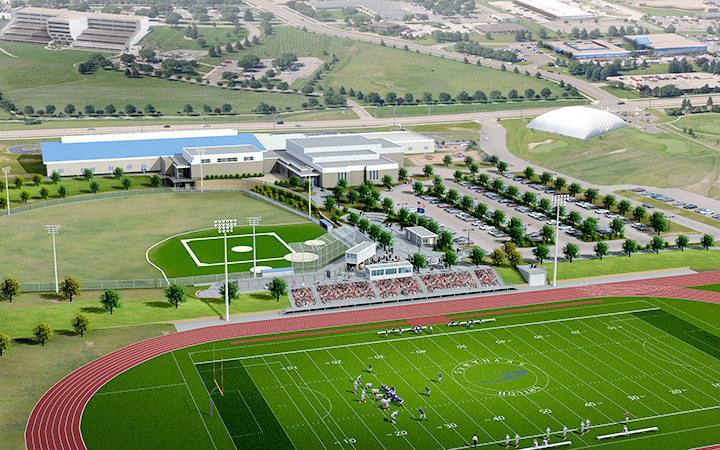Considerations for natural grass and turf surfaces
There are plenty of choices to be made when putting in a field but one of the first is whether that field will have a natural grass or a synthetic turf surface.
To be clear: There is no right choice or wrong choice; there is only the choice that is right for the individual school. However, since surface selection will affect almost every aspect of the project, decisions need to be made early on in the planning process.
Start by Asking QuestionsDon’t expect to find definitive answers by doing random Internet searches; the information you find may be biased or just plain inaccurate. Instead, start by gathering information specific to your project.

Key questions that should be asked include the following:
- What sport (or sports) will the field host?
- Which game lines do you anticipate needing on the field?
- At what level will sports be played (high school, collegiate, recreational, club, etc.)?
- Will the local community have access to the field? Will this use be supervised or unsupervised?
- If the field hosts multiple sports, is it likely to see use throughout the year or during certain seasons?
- How much time will the field have to rest between periods of heavy use? (If this time will be limited or nonexistent, a synthetic surface may be the better choice.)
- Will a track be included in the project? If so, are field events planned, and if so, which of those will be placed in the infield? (Some field events traditionally conducted in the infield, including the hammer throw and javelin, may need to be relocated if a synthetic surface is chosen.)
- Will the field be used during the summer for events such as travel tournaments?
- Do you plan to use the field for graduations, concerts, festivals, fireworks, or other non-sports activities? What type of field protection will be required? How much turnaround time is available between sports events and alternate field uses?
- What is the budget for maintenance? What is your staff’s training? Do you have enough staff? Realistically, what can the staff do, and what must be contracted out? Expert and diligent maintenance is necessary to extend the useful life of any playing surface. Can you afford the required level of maintenance while providing a reserve for eventual replacement?
- What are the local weather conditions — such as freeze/thaw or minimum/ maximum temperatures? Will the field be used during times of the year when temperatures, precipitation and/or drought are extreme? How much does it rain? How soon will the field need to be available for play after rain?
- Are there local water use restrictions that will affect irrigation?
- What is the availability of materials locally? If materials such as stone, topsoil, compost, or sand must be trucked in, this will impact the budget.
- What type of natural soil do you have? Will it need to be amended if a grass field is planned?
- What type of security will be available to protect the field from vandalism or misuse? Security might include fences and gates, lighting, security personnel, etc. Grass fields are less expensive to repair if damaged.
- Have you considered accessibility? What state, local, and national standards for accessible design must be met? While the Americans with Disabilities Act (ADA) often comes to mind, advocates for those with physical and developmental challenges view the ADA as a baseline, rather than a standard. Other jurisdictions including states, counties, and incorporated areas also have their own standards.
These are a few of the questions that need to be taken into consideration. They are by no means the only ones; however, the more information you can bring to the table when you meet with the professional who will be building your field (more on this in a minute), the better off you will be.
Be Aware of Developments in the Industry

Another aspect of decision-making is staying on top of the changes in the industry itself.
Health and Safety Factors: In mid-April, the Environmental Protection Agency (EPA) published a multi-agency research report reaffirming the safety of synthetic turf sports fields that use crumb rubber infill. The study found no significant difference in the exposure to certain chemicals between players who played on synthetic turf fields that use crumb rubber infill and those who played on grass fields. More information on this is available from the EPA’s website.
Additionally, a more recent study found that synthetic fields actually have a lower incidence of concussion than natural grass. That study, conducted by researchers at UT Southwestern Medical Center and published in the Clinical Journal of Sports Medicine, studied football players between the ages of 10 and 24 years old who had had a concussion. The findings were that players on natural grass experienced more severe concussions and a higher number of symptoms than those who played on synthetic turf.
Work with a Sports-Specific Contractor
Whatever the chosen surface will be, the field must be built correctly, with attention to design, drainage, and more. A well-built field will be a pleasure for athletes to use and an asset to the school. Using a contractor with sports field-specific experience will be key to the success of the project. The contractor can work with the school, taking into account its needs, and will be able to make recommendations on the best surface for the project.
» ALSO SEE: Q&A.D. with RIIL executive director Michael Lunney
One avenue for finding a sport-specific contractor is to use the “Find a Builder” feature on the website of the American Sports Builders Association (www.sportsbuilders.org). Additionally, more detailed information on choosing a surface for a field can be found in the publication, Sports Fields: Construction and Maintenance Manual, also available from the ASBA website by going to the top blue toolbar and mousing over to “Resources.” A drop-down menu will appear, including “Publications.”





